November 2005
RIM dealt another blow in patent lawsuit
RIM's offer/settlement to pay a company called NTP US$450 million over a patent dispute was apparently not good enough, and so a judge threw out RIM's offer. This means that RIM may have to pay NTP over a billion dollars in order to keep its wireless service running in the United States. This most unfortunate lawsuit has been going on for years, and is yet another example of a blatant attempt at profiteering off the success of technology pioneers like RIM. Remember how Palm faced a similar situation when Xerox sued Palm over patent infringement with Graffiti? Palm's energy and focus was diverted for years, and they even abandoned the original Graffiti (doubtlessly to significant harm to them) until the lawsuit was thrown out because it had no merit. Yet, Palm was wounded and has never been the same. We certainly hope the same won't happen to RIM. [read RIM's update on the litigation] -- Posted Wednesday, November 30, 2005 by chb
Symbol and Avaya provide VoIP mobility solution
Symbol Technologies and business communications applications specialist Avaya Inc. announced the availability of a mobility solution that helps mobile professionals access essential enterprise applications as they roam throughout their workplace. The solution integrates Symbol's data capture, mobile computing platforms, and wireless infrastructure with Avaya's IP telephony software and mobile client applications. It combines Symbol's award-winning MC50 Enterprise Digital Assistant, WS5100 Wireless Switch, and AP300 Access Port with the Avaya IP Softphone based on the Avaya Communication Manager platform. The solution is ideal for retail, healthcare, manufacturing and environments where campus workers require mobile computers, scanners and other technologies combined with voice communications. [see full release]
-- Posted Wednesday, November 30, 2005 by chb
O'Neil mobile printer for popular Dolphin 7900
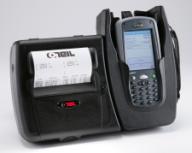 O'Neil Product Development released the PrintPAD 7900 that combines their 4" thermal printer with an integrated cradle for Hand Held Products' popular Dolphin 7900 rugged mobile computer. The cradle assembly also uses Bluetooth so that it can be sued to print even when the terminal is not inserted. The rugged PrintPAD can print well over 2,000 6" receipts or other short documents on a single charge, making it perfect for route accounting, store deliveries and many other mobile field applications. -- Posted Wednesday, November 30, 2005 by chb
O'Neil Product Development released the PrintPAD 7900 that combines their 4" thermal printer with an integrated cradle for Hand Held Products' popular Dolphin 7900 rugged mobile computer. The cradle assembly also uses Bluetooth so that it can be sued to print even when the terminal is not inserted. The rugged PrintPAD can print well over 2,000 6" receipts or other short documents on a single charge, making it perfect for route accounting, store deliveries and many other mobile field applications. -- Posted Wednesday, November 30, 2005 by chb
Bluetooth growing in leaps and bounds
The Bluetooth Special Interest Group announced that the Bluetooth market is now shipping an amazing 9.5 million Bluetooth units PER WEEK, twice as many as just half a year ago. Dr. Michael Foley, executive director of the Bluetooth SIG, views that as a rousing endorsement of Bluetooth as the personal area network of choice for mobile phones, portable computers, cars, stereo headsets, MP3 players, and more. For comprehensive information on the current state of Bluetooth, check the Bluetooth website. -- Posted Tuesday, November 29, 2005 by chb
Visual Voicemail now on Palm Treo, other mobiles
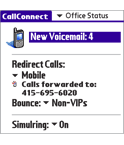 Mobile workers know the tedious voicemail routine: Call voicemail, enter PIN, wade through menus to sequentially to one message after the other. Skip, save, delete, repeat. Visual Voicemail from Traverse Networks changes all that, delivering voicemail to mobile devices within an email-like inbox. Visual Voicemail is available as a stand alone solution or as a fully integrated component of CallConnect that provides complete control of a corporate office phone from mobile devices including Palm Treos, RIM Blackberries and Symbian based smartphones. Very clever. -- Posted Monday, November 28, 2005 by chb
Mobile workers know the tedious voicemail routine: Call voicemail, enter PIN, wade through menus to sequentially to one message after the other. Skip, save, delete, repeat. Visual Voicemail from Traverse Networks changes all that, delivering voicemail to mobile devices within an email-like inbox. Visual Voicemail is available as a stand alone solution or as a fully integrated component of CallConnect that provides complete control of a corporate office phone from mobile devices including Palm Treos, RIM Blackberries and Symbian based smartphones. Very clever. -- Posted Monday, November 28, 2005 by chb
Microsoft tweaks Hosted Messaging and Collaboration for Mobile
Microsoft announced its Solution for Hosted Messaging and Collaboration version 3.5, a hosted solution that enables service providers to equip small and midsize businesses with enterprise-class email services, mobile device data access, team websites and online presence information. In version 3.5, Microsoft incorporates new mobile synchronisation capabilities taking advantage of Windows Mobile 5.0, direct push of email and PIM data without the need for SMS, remote device wipe of sensitive data from lost or stolen devices, a variety of security enhancements, and new tools that lessen management time and extend customer acquisition opportunities for hosting partners. Sign up for free Hosted Messaging seminars -- Posted Monday, November 28, 2005 by chb
Acer introduces TravelMate C200 Tablet PC
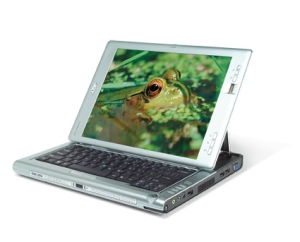 Acer America introduced the TravelMate C200 series of Tablet PC convertibles. Unlike most convertibles to-date, the C200 uses a patented sliding-track mechanism for a much more stable writing surface than the common pivot/swivel mechanism used by almost all other Tablet PC convertibles provides. The C200 has a 12.1" display, uses either a 2GHz Pentium M 760 or a 1.5GHz Celeron M 370, has up to 2GB of RAM, up to 100GB of disk, and a slot-loading DVD burner or conventional DVD/CD-RW. The device also has a 4-in-1 card reader, 802.11a/b/g WiFi, Bluetooth, Gigabit LAN, and a 56k modem. There are three USB 2.0 ports and Firewire. Prices start at US$1,399. A top-of-the-line model with biometric fingerprint scanner gos for US$1,899. Our take: it's about time someone re-introduced a more stable solution than the ubiquitous but pretty useless pivot. IBM used a similar solution many years ago on its P750 and P360 Thinkpads. [see press release] [see Acer product page] -- Posted Tuesday, November 22, 2005 by chb
Acer America introduced the TravelMate C200 series of Tablet PC convertibles. Unlike most convertibles to-date, the C200 uses a patented sliding-track mechanism for a much more stable writing surface than the common pivot/swivel mechanism used by almost all other Tablet PC convertibles provides. The C200 has a 12.1" display, uses either a 2GHz Pentium M 760 or a 1.5GHz Celeron M 370, has up to 2GB of RAM, up to 100GB of disk, and a slot-loading DVD burner or conventional DVD/CD-RW. The device also has a 4-in-1 card reader, 802.11a/b/g WiFi, Bluetooth, Gigabit LAN, and a 56k modem. There are three USB 2.0 ports and Firewire. Prices start at US$1,399. A top-of-the-line model with biometric fingerprint scanner gos for US$1,899. Our take: it's about time someone re-introduced a more stable solution than the ubiquitous but pretty useless pivot. IBM used a similar solution many years ago on its P750 and P360 Thinkpads. [see press release] [see Acer product page] -- Posted Tuesday, November 22, 2005 by chb
New BlackBerry has Broadband access
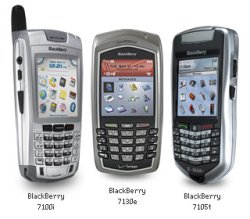 RIM and Verizon Wireless introduced the BlackBerry 7130e, the first to take advantage of Verizon's "BroadbandAccess" on its EV-DO (Evolution-Data Optimized) service. This allows using the 7130e as a modem to download documents to a notebook at between 400 and 700 kbps--quite remarkable. The new data service adds $15-$30 to a standard monthly BlackBerry bill, depending on the service plan. Other than that, the 7130e is another step in RIM devices' evolution to more PDA-like capabilities and display quality while, of course, retaining the still unmatched push-based RIM wireless email. Our take: We still prefer the 8700 Series' thumbtype keyboards over weird hybrid keypads, but RIM's push to make their devices ever more useful is most impressive. Let's hope those obnoxious patent infringement lawsuits are settled real soon. Nasty stuff, that. -- Posted Monday, November 21, 2005 by chb
RIM and Verizon Wireless introduced the BlackBerry 7130e, the first to take advantage of Verizon's "BroadbandAccess" on its EV-DO (Evolution-Data Optimized) service. This allows using the 7130e as a modem to download documents to a notebook at between 400 and 700 kbps--quite remarkable. The new data service adds $15-$30 to a standard monthly BlackBerry bill, depending on the service plan. Other than that, the 7130e is another step in RIM devices' evolution to more PDA-like capabilities and display quality while, of course, retaining the still unmatched push-based RIM wireless email. Our take: We still prefer the 8700 Series' thumbtype keyboards over weird hybrid keypads, but RIM's push to make their devices ever more useful is most impressive. Let's hope those obnoxious patent infringement lawsuits are settled real soon. Nasty stuff, that. -- Posted Monday, November 21, 2005 by chb
Nokia buys Intellisync
In a move that may or may not bode ill to competing OS platforms, Nokia and Intellisync announced they have signed an agreement for Nokia to acquire Intellisync, a leader in platform-independent wireless messaging and applications for mobile devices. Intellisync stockholders will receive US$5.25 per share in cash for each Intellisync common share. The transaction is expected to be completed in the first quarter of 2006. Intellisync was founded in 1993 and has approximately 450 employees. Our take: Whether longtime PDA synchronization stalwart Intellisync will still "power virtually any device" in the future will remain to be seen.
[see Nokia release] -- Posted Thursday, November 17, 2005 by chb
Symbian's staggering numbers
While the PDA market seems to be stagnating at best for now, the numbers of Symbian-powered advanced handsets is huge and growing. No less than 8.5 million Symbia handsets were shipped in Q3 of 2005 (and a total of over 23 million for the first three quarters) and the installed base of Symbian OS users is now almost 50 million. 60 Symbian OS phones from eight licensees are shipping, and that many more are under development. Fujitsu, Nokia, Mitsubishi and Samsung all released advanced new EDGE, GSM/GPRS and FOMA phones. For more info see All About Symbian. -- Posted Thursday, November 17, 2005 by chb
Acer aims to become a force in PDAs
Digitimes reports that according to its chairman, Acer may sell 700,000 PDAs in fiscal 2005, up from just over 100,000 last year. The sales will continue to climb 114% in 2006, when the company’s ranking in the global PDA market is expected to rise from third to second. Acer current PDA lineup, the n30, n35 and n50, are manufactured by Lite-On Technology. IDC recently reported the handheld device market totaled 1.68 million units worldwide in the third quarter of 2005, with Acer enjoying the most on-year growth among the top-five vendors. -- Posted Thursday, November 17, 2005 by chb
PalmSource acquisition final
Japan's Access and its US branch announced it has completed the acquisition of PalmSource which is now a wholly owned subsidiary of Access and no longer traded as a separate company. Each share of PalmSource has been converted into the right to receive US$18.50 in cash. Up to now, almost 40 million devices using the Palm OS have been sold. According to CNET's news.com Palm CEO Ed Colligan had told Computer Business Review in October that he probably would not have separated PalmSource from Palm had he been in charge at the time. It also reported that Motorola had launched a failed US$17.25 per share bid for PalmSource. -- Posted Wednesday, November 16, 2005 by chb
Handwriting reco comes to game machines
Zi Corporation, which provides intelligent interface solutions, has signed a licensing agreement with Nintendo where Nintendo DS developers can employ Zi's Decuma handwriting recognition technology in games for the Nintendo DS handheld video game system. The Nintendo DS has two screens, one of which uses touch-screen technology. Users can interact with the Nintendo DS by using standard control buttons, a microphone or the touch screen. While this seems an odd concept, some of the early DS games that use the touch screen are very compelling and definitely enrich the gaming experience. Zi Corporationsaid, "With Decuma, Nintendo DS users will experience natural handwriting recognition previously only available to PDA and smartphone users. Zi continues to bring its multi-modal input products to leading mobile phones, gaming platforms and smartphones across the globe." [see press release] -- Posted Tuesday, November 15, 2005 by chb
SynapticsDual Mode TouchPad holds potential
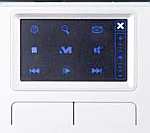 Interface solutions specialist Synaptics' Dual Mode TouchPad module transforms the Synaptics notebook TouchPad from a navigation device to a media control center with the touch of a button. In default navigation mode, the TouchPad provides cursor navigation. When the dual mode button is engaged blue LEDs illuminate application icons and controls on the pad. The illuminated interface offers multimedia controls, including volume, play/pause, stop, previous, next and mute, and also application launch buttons for Internet Explorer, search, mail, and media player. To switch from cursor mode to media mode, users tap on the upper right tap zone on the TouchPad module. The Dual Mode TouchPad is now shipping with the new Medion MD 96500 notebook computer. It's easy to see many other mobile/tablet applications for this interesting technology. [see release] -- Posted Monday, November 14, 2005 by chb
Interface solutions specialist Synaptics' Dual Mode TouchPad module transforms the Synaptics notebook TouchPad from a navigation device to a media control center with the touch of a button. In default navigation mode, the TouchPad provides cursor navigation. When the dual mode button is engaged blue LEDs illuminate application icons and controls on the pad. The illuminated interface offers multimedia controls, including volume, play/pause, stop, previous, next and mute, and also application launch buttons for Internet Explorer, search, mail, and media player. To switch from cursor mode to media mode, users tap on the upper right tap zone on the TouchPad module. The Dual Mode TouchPad is now shipping with the new Medion MD 96500 notebook computer. It's easy to see many other mobile/tablet applications for this interesting technology. [see release] -- Posted Monday, November 14, 2005 by chb
PCMCIA ExpressCard makes inroad
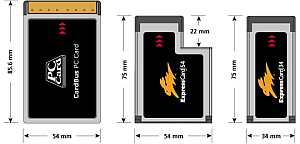 Once upon a time, the PC Card ruled the expansion card field. Today, those cards look quaintly huge and have long been replaced by CF Cards, Memory Sticks, SF Cards and other smaller formats. For most applications, but not all. That's because the smaller formats generally can't provide serious hardware expansion. That's where the PCMCIA's ExpressCard comes in. PCMCIA calls them the plug-in I/O cards for the next generation of PC devices. There are two form factors (2.1 x 3.4 and 1.35 x 3), both smaller than the old PC Card. Both support the USB 2.0 and PCI Express interface--much faster than the old CardBus. PCMCIA just completed its 5th ExpressCard Compliance Workshop in Taiwan, with 15 companies testing 32 products. At this point, the ExpressCard standard is used in more than 95% of all notebooks, giving the PCMCIA ExpressCard a good chance for success. [see ExpressCard site for all information] -- Posted Monday, November 14, 2005 by chb
Once upon a time, the PC Card ruled the expansion card field. Today, those cards look quaintly huge and have long been replaced by CF Cards, Memory Sticks, SF Cards and other smaller formats. For most applications, but not all. That's because the smaller formats generally can't provide serious hardware expansion. That's where the PCMCIA's ExpressCard comes in. PCMCIA calls them the plug-in I/O cards for the next generation of PC devices. There are two form factors (2.1 x 3.4 and 1.35 x 3), both smaller than the old PC Card. Both support the USB 2.0 and PCI Express interface--much faster than the old CardBus. PCMCIA just completed its 5th ExpressCard Compliance Workshop in Taiwan, with 15 companies testing 32 products. At this point, the ExpressCard standard is used in more than 95% of all notebooks, giving the PCMCIA ExpressCard a good chance for success. [see ExpressCard site for all information] -- Posted Monday, November 14, 2005 by chb
Iomega releases 4 and 8GB Micro Mini hard drives
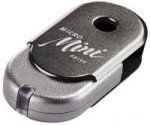 Storage medium veteran Iomea certainly has had its ups and downs over the years. The (massive) original Bernoulli Box was very cool, and so were the ZIP disks in their day. There were a number of flops as well, but now Iomega has something interesting in higher capacity versions of its tiny shockmounted Micro Mini hard drives. The 1.75 ounce 4200rpm drives are smaller than most USB keys, have an ingenious fold-away USB 2.0 neck, are powered by the USB port when you plug them in, and even have a lower price per gigabyte than flash USB keys. It comes with backup and music management software for Mac and PC, and Adobe Photoshop Album SE for PC. Suggested retail is US$129.95 for the 4GB and US$169.95 for the 8GB model. -- Posted Thursday, November 10, 2005 by chb
Storage medium veteran Iomea certainly has had its ups and downs over the years. The (massive) original Bernoulli Box was very cool, and so were the ZIP disks in their day. There were a number of flops as well, but now Iomega has something interesting in higher capacity versions of its tiny shockmounted Micro Mini hard drives. The 1.75 ounce 4200rpm drives are smaller than most USB keys, have an ingenious fold-away USB 2.0 neck, are powered by the USB port when you plug them in, and even have a lower price per gigabyte than flash USB keys. It comes with backup and music management software for Mac and PC, and Adobe Photoshop Album SE for PC. Suggested retail is US$129.95 for the 4GB and US$169.95 for the 8GB model. -- Posted Thursday, November 10, 2005 by chb
Handango launches Tablet PC Catalog
Mobile systems software vendor Handango has entered the market for downloadable Tablet PC software with the launch of a Tablet PC catalog. Customers can download applications at Handango's Web site and on the Microsoft Windows XP Tablet PC Software store. Now, Tablet PC owners have a place to discover and download the best selection of software for their Tablet PCs. Additionally, Handango has extended its robust marketplace platform, Handango AMPP, to support Tablet PC applications, enabling Tablet PC manufacturers to create new streams of revenue through their own branded software storefronts. -- Posted Tuesday, November 8, 2005 by chb
PDA sales UP! No, DOWN! No, UP! No, DOWN!
Mobilemag.com: "Gartner predicts PDA sales to sky rocket this year -- According to a report by Gartner, the shipment of PDAs in Q3, 2005 has registered a staggering growth of nearly 21 percent over the corresponding period last year. The total shipment figure in the given period stood at a commendable 3.45 million units. On the basis of this trend, Gartner has projected a record sale of nearly 15 million units of PDAs this year which will far exceed the best ever PDA shipments figure of 13.2 million units registered in 2001."
Betanews.com: "PDA Sales Continue to Decline -- Handheld devices continued to fall out of favor with consumers, according to a report released by market research firm IDC. In the third quarter of 2005, handheld sales fell 8.8 percent compared with last quarter, and 16.9 percent year over year. Even with the declines, device manufacturers are continuing to release new products, many featuring some type of wireless connectivity. While IDC expects an uptick in sales sequentially from quarter to quarter, sales will likely miss last year's numbers." -- Posted Monday, November 7, 2005 by chb
Netgear launches blazing-speed wireless product line
NETGEAR announced its RangeMax 240 family of wireless networking products, a wireless networking solution capable of delivering data at wireless speeds up to 240 Mbps. That's wireless which is fast enough to support simultaneous bandwidth-intensive applications such as high-definition video, Voice-over-IP (VoIP) telephony, streaming audio, and online gaming. The RangeMax 240 Wireless Router (WPNT834) uses MIMO technology with Adaptive Channel Expansion. When used with the RangeMax 240 Wireless Notebook Adapter (WPNT511) and USB 2.0 Adapter (WPNT121) you can get wireless effective throughput of up to 100Mbps comparable to that of 10/100 Fast Ethernet wired networks. It is compatible with and connects simultaneously to RangeMax 240, RangeMax, and all other 802.11b/g clients. RangeMax 240 dynamically avoids interference from neighboring wireless networks to maintain the most reliable, high-performance, long-range network connection. Our view: Of course, we've seen faster-than-standard wireless before and it usually comes at the expense of compatibility and, well, being a standard, but this kind of speed shows where we're headed. -- Posted Monday, November 7, 2005 by chb
Tiny Nokia 770 Internet Tablet now shipping
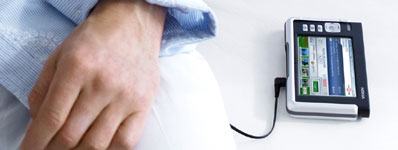 What is this? Deja-vue all over again with a little webpad? Didn't we go through this four years ago and it went nowhere? Didn't even mighty Microsoft throw in its towel with the shortlives Mira/SmartDisplay? Well, Nokia has never been one to shy away from a challenge in its never-ending quest for wireless supremacy, and hence the Nokia 770 Internet Tablet. It's a 5.6 x 3.2 x 0.8 inch black and matte-silver mini-tablet that weighs 8.1 ounces, has a 65k color 4.1-inch 800 x 480 pixel touchscreen 128MB of flash (over 64MB available to the user), a RS-MMC card, Bluetooth, 802.11b/g WiFi, a 1,500mAH battery good for 3 hours' worh of browsing, and it runs the Linux "Internet Tablet 2005 software edition". Though this is a Nokia device, no telephony. That'll happen next year with the 2006 Internet Tablet edition that supports VoIP and Instant Messaging. -- Posted Monday, November 7, 2005 by chb
What is this? Deja-vue all over again with a little webpad? Didn't we go through this four years ago and it went nowhere? Didn't even mighty Microsoft throw in its towel with the shortlives Mira/SmartDisplay? Well, Nokia has never been one to shy away from a challenge in its never-ending quest for wireless supremacy, and hence the Nokia 770 Internet Tablet. It's a 5.6 x 3.2 x 0.8 inch black and matte-silver mini-tablet that weighs 8.1 ounces, has a 65k color 4.1-inch 800 x 480 pixel touchscreen 128MB of flash (over 64MB available to the user), a RS-MMC card, Bluetooth, 802.11b/g WiFi, a 1,500mAH battery good for 3 hours' worh of browsing, and it runs the Linux "Internet Tablet 2005 software edition". Though this is a Nokia device, no telephony. That'll happen next year with the 2006 Internet Tablet edition that supports VoIP and Instant Messaging. -- Posted Monday, November 7, 2005 by chb
Two new Asus GPS Pocket PCs
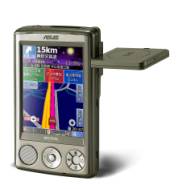 Asus announced two new "Global Positioning Systems devices" (is Pocket PC becoming a dirty word?) that for now are available in Europe and Taiwan. They are the MyPal A632 and A636. Both use the Sirf Star III GPS module, use a 416MHz Intel PCA processor and run Windows Mobile 5.0 for Pocket PC. Other specs: 128MB Flash ROM and 64MB RAM, 1,300mAH removable Li-Ion battery, Bluetooth, dimensions of 4.8x2.9x0.75 inches, and a weight of 6.7 ounces. The A636 model (projected at US$560) has one SDIO slot and 802.11b WiFi, whereas the US$500 A632 model has no WiFi but, interestingly, dual SDIO slots that also support MiniSD. -- Posted Friday, November 4, 2005 by chb
Asus announced two new "Global Positioning Systems devices" (is Pocket PC becoming a dirty word?) that for now are available in Europe and Taiwan. They are the MyPal A632 and A636. Both use the Sirf Star III GPS module, use a 416MHz Intel PCA processor and run Windows Mobile 5.0 for Pocket PC. Other specs: 128MB Flash ROM and 64MB RAM, 1,300mAH removable Li-Ion battery, Bluetooth, dimensions of 4.8x2.9x0.75 inches, and a weight of 6.7 ounces. The A636 model (projected at US$560) has one SDIO slot and 802.11b WiFi, whereas the US$500 A632 model has no WiFi but, interestingly, dual SDIO slots that also support MiniSD. -- Posted Friday, November 4, 2005 by chb
 O'Neil Product Development released the PrintPAD 7900 that combines their 4" thermal printer with an integrated cradle for Hand Held Products' popular Dolphin 7900 rugged mobile computer. The cradle assembly also uses Bluetooth so that it can be sued to print even when the terminal is not inserted. The rugged PrintPAD can print well over 2,000 6" receipts or other short documents on a single charge, making it perfect for route accounting, store deliveries and many other mobile field applications. -- Posted Wednesday, November 30, 2005 by chb
O'Neil Product Development released the PrintPAD 7900 that combines their 4" thermal printer with an integrated cradle for Hand Held Products' popular Dolphin 7900 rugged mobile computer. The cradle assembly also uses Bluetooth so that it can be sued to print even when the terminal is not inserted. The rugged PrintPAD can print well over 2,000 6" receipts or other short documents on a single charge, making it perfect for route accounting, store deliveries and many other mobile field applications. -- Posted Wednesday, November 30, 2005 by chb Mobile workers know the tedious voicemail routine: Call voicemail, enter PIN, wade through menus to sequentially to one message after the other. Skip, save, delete, repeat. Visual Voicemail from
Mobile workers know the tedious voicemail routine: Call voicemail, enter PIN, wade through menus to sequentially to one message after the other. Skip, save, delete, repeat. Visual Voicemail from  Acer America introduced the TravelMate C200 series of Tablet PC convertibles. Unlike most convertibles to-date, the C200 uses a patented sliding-track mechanism for a much more stable writing surface than the common pivot/swivel mechanism used by almost all other Tablet PC convertibles provides. The C200 has a 12.1" display, uses either a 2GHz Pentium M 760 or a 1.5GHz Celeron M 370, has up to 2GB of RAM, up to 100GB of disk, and a slot-loading DVD burner or conventional DVD/CD-RW. The device also has a 4-in-1 card reader, 802.11a/b/g WiFi, Bluetooth, Gigabit LAN, and a 56k modem. There are three USB 2.0 ports and Firewire. Prices start at US$1,399. A top-of-the-line model with biometric fingerprint scanner gos for US$1,899. Our take: it's about time someone re-introduced a more stable solution than the ubiquitous but pretty useless pivot. IBM used a similar solution many years ago on its P750 and P360 Thinkpads. [
Acer America introduced the TravelMate C200 series of Tablet PC convertibles. Unlike most convertibles to-date, the C200 uses a patented sliding-track mechanism for a much more stable writing surface than the common pivot/swivel mechanism used by almost all other Tablet PC convertibles provides. The C200 has a 12.1" display, uses either a 2GHz Pentium M 760 or a 1.5GHz Celeron M 370, has up to 2GB of RAM, up to 100GB of disk, and a slot-loading DVD burner or conventional DVD/CD-RW. The device also has a 4-in-1 card reader, 802.11a/b/g WiFi, Bluetooth, Gigabit LAN, and a 56k modem. There are three USB 2.0 ports and Firewire. Prices start at US$1,399. A top-of-the-line model with biometric fingerprint scanner gos for US$1,899. Our take: it's about time someone re-introduced a more stable solution than the ubiquitous but pretty useless pivot. IBM used a similar solution many years ago on its P750 and P360 Thinkpads. [ RIM and Verizon Wireless introduced the
RIM and Verizon Wireless introduced the  Interface solutions specialist Synaptics' Dual Mode TouchPad module transforms the Synaptics notebook TouchPad from a navigation device to a media control center with the touch of a button. In default navigation mode, the TouchPad provides cursor navigation. When the dual mode button is engaged blue LEDs illuminate application icons and controls on the pad. The illuminated interface offers multimedia controls, including volume, play/pause, stop, previous, next and mute, and also application launch buttons for Internet Explorer, search, mail, and media player. To switch from cursor mode to media mode, users tap on the upper right tap zone on the TouchPad module. The Dual Mode TouchPad is now shipping with the new Medion MD 96500 notebook computer. It's easy to see many other mobile/tablet applications for this interesting technology. [
Interface solutions specialist Synaptics' Dual Mode TouchPad module transforms the Synaptics notebook TouchPad from a navigation device to a media control center with the touch of a button. In default navigation mode, the TouchPad provides cursor navigation. When the dual mode button is engaged blue LEDs illuminate application icons and controls on the pad. The illuminated interface offers multimedia controls, including volume, play/pause, stop, previous, next and mute, and also application launch buttons for Internet Explorer, search, mail, and media player. To switch from cursor mode to media mode, users tap on the upper right tap zone on the TouchPad module. The Dual Mode TouchPad is now shipping with the new Medion MD 96500 notebook computer. It's easy to see many other mobile/tablet applications for this interesting technology. [ Once upon a time, the PC Card ruled the expansion card field. Today, those cards look quaintly huge and have long been replaced by CF Cards, Memory Sticks, SF Cards and other smaller formats. For most applications, but not all. That's because the smaller formats generally can't provide serious hardware expansion. That's where the PCMCIA's ExpressCard comes in. PCMCIA calls them the plug-in I/O cards for the next generation of PC devices. There are two form factors (2.1 x 3.4 and 1.35 x 3), both smaller than the old PC Card. Both support the USB 2.0 and PCI Express interface--much faster than the old CardBus. PCMCIA just completed its 5th ExpressCard Compliance Workshop in Taiwan, with 15 companies testing 32 products. At this point, the ExpressCard standard is used in more than 95% of all notebooks, giving the PCMCIA ExpressCard a good chance for success. [
Once upon a time, the PC Card ruled the expansion card field. Today, those cards look quaintly huge and have long been replaced by CF Cards, Memory Sticks, SF Cards and other smaller formats. For most applications, but not all. That's because the smaller formats generally can't provide serious hardware expansion. That's where the PCMCIA's ExpressCard comes in. PCMCIA calls them the plug-in I/O cards for the next generation of PC devices. There are two form factors (2.1 x 3.4 and 1.35 x 3), both smaller than the old PC Card. Both support the USB 2.0 and PCI Express interface--much faster than the old CardBus. PCMCIA just completed its 5th ExpressCard Compliance Workshop in Taiwan, with 15 companies testing 32 products. At this point, the ExpressCard standard is used in more than 95% of all notebooks, giving the PCMCIA ExpressCard a good chance for success. [ Storage medium veteran Iomea certainly has had its ups and downs over the years. The (massive) original Bernoulli Box was very cool, and so were the ZIP disks in their day. There were a number of flops as well, but now Iomega has something interesting in higher capacity versions of its tiny shockmounted Micro Mini hard drives. The 1.75 ounce 4200rpm drives are smaller than most USB keys, have an ingenious fold-away USB 2.0 neck, are powered by the USB port when you plug them in, and even have a lower price per gigabyte than flash USB keys. It comes with backup and music management software for Mac and PC, and Adobe Photoshop Album SE for PC. Suggested retail is US$129.95 for the 4GB and US$169.95 for the 8GB model. -- Posted Thursday, November 10, 2005 by
Storage medium veteran Iomea certainly has had its ups and downs over the years. The (massive) original Bernoulli Box was very cool, and so were the ZIP disks in their day. There were a number of flops as well, but now Iomega has something interesting in higher capacity versions of its tiny shockmounted Micro Mini hard drives. The 1.75 ounce 4200rpm drives are smaller than most USB keys, have an ingenious fold-away USB 2.0 neck, are powered by the USB port when you plug them in, and even have a lower price per gigabyte than flash USB keys. It comes with backup and music management software for Mac and PC, and Adobe Photoshop Album SE for PC. Suggested retail is US$129.95 for the 4GB and US$169.95 for the 8GB model. -- Posted Thursday, November 10, 2005 by  What is this? Deja-vue all over again with a little webpad? Didn't we go through this four years ago and it went nowhere? Didn't even mighty Microsoft throw in its towel with the shortlives Mira/SmartDisplay? Well, Nokia has never been one to shy away from a challenge in its never-ending quest for wireless supremacy, and hence the Nokia 770 Internet Tablet. It's a 5.6 x 3.2 x 0.8 inch black and matte-silver mini-tablet that weighs 8.1 ounces, has a 65k color 4.1-inch 800 x 480 pixel touchscreen 128MB of flash (over 64MB available to the user), a RS-MMC card, Bluetooth, 802.11b/g WiFi, a 1,500mAH battery good for 3 hours' worh of browsing, and it runs the Linux "Internet Tablet 2005 software edition". Though this is a Nokia device, no telephony. That'll happen next year with the 2006 Internet Tablet edition that supports VoIP and Instant Messaging. -- Posted Monday, November 7, 2005 by
What is this? Deja-vue all over again with a little webpad? Didn't we go through this four years ago and it went nowhere? Didn't even mighty Microsoft throw in its towel with the shortlives Mira/SmartDisplay? Well, Nokia has never been one to shy away from a challenge in its never-ending quest for wireless supremacy, and hence the Nokia 770 Internet Tablet. It's a 5.6 x 3.2 x 0.8 inch black and matte-silver mini-tablet that weighs 8.1 ounces, has a 65k color 4.1-inch 800 x 480 pixel touchscreen 128MB of flash (over 64MB available to the user), a RS-MMC card, Bluetooth, 802.11b/g WiFi, a 1,500mAH battery good for 3 hours' worh of browsing, and it runs the Linux "Internet Tablet 2005 software edition". Though this is a Nokia device, no telephony. That'll happen next year with the 2006 Internet Tablet edition that supports VoIP and Instant Messaging. -- Posted Monday, November 7, 2005 by  Asus announced two new "Global Positioning Systems devices" (is Pocket PC becoming a dirty word?) that for now are available in Europe and Taiwan. They are the MyPal A632 and A636. Both use the Sirf Star III GPS module, use a 416MHz Intel PCA processor and run Windows Mobile 5.0 for Pocket PC. Other specs: 128MB Flash ROM and 64MB RAM, 1,300mAH removable Li-Ion battery, Bluetooth, dimensions of 4.8x2.9x0.75 inches, and a weight of 6.7 ounces. The A636 model (projected at US$560) has one SDIO slot and 802.11b WiFi, whereas the US$500 A632 model has no WiFi but, interestingly, dual SDIO slots that also support MiniSD. -- Posted Friday, November 4, 2005 by
Asus announced two new "Global Positioning Systems devices" (is Pocket PC becoming a dirty word?) that for now are available in Europe and Taiwan. They are the MyPal A632 and A636. Both use the Sirf Star III GPS module, use a 416MHz Intel PCA processor and run Windows Mobile 5.0 for Pocket PC. Other specs: 128MB Flash ROM and 64MB RAM, 1,300mAH removable Li-Ion battery, Bluetooth, dimensions of 4.8x2.9x0.75 inches, and a weight of 6.7 ounces. The A636 model (projected at US$560) has one SDIO slot and 802.11b WiFi, whereas the US$500 A632 model has no WiFi but, interestingly, dual SDIO slots that also support MiniSD. -- Posted Friday, November 4, 2005 by